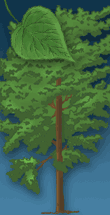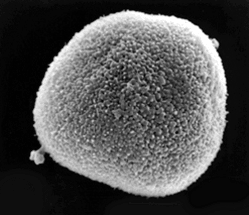Click on the name of a different pollen below to find out more about
it,
or click on the other microscope for a different view of this pollen.
| Plant: | Pollen: | Microscope: |
 |
 |
|
|
Cottonwood Cottonwoods are old giants of the prairies, where they grow along rivers and streams. They get their name from the cottony seeds that blow about in May and June. Some people may be allergic to the cotton in the air, but many more people are allergic to the pollen that spreads on the wind earlier in the spring. Like many wind-pollinated trees, cottonwoods bloom before the leaves unfold. That way the flowers have a chance to catch the pollen from other trees before the leaves act as a barrier. Cottonwood flowers look more like strings of beads than blossoms. The male flowers make heavy amounts of very light pollen. Cottonwood pollen is so fragile that it breaks apart easily. Because of this, paleontologists looking for fossil cottonwood pollen doubted whether they would find any that they could recognize. Luckily, they have found some good specimens in peat bogs, a soft type of soil that catches pollen and preserves it for a very long time. Finding fossil pollen helps scientists understand the history of forests. |